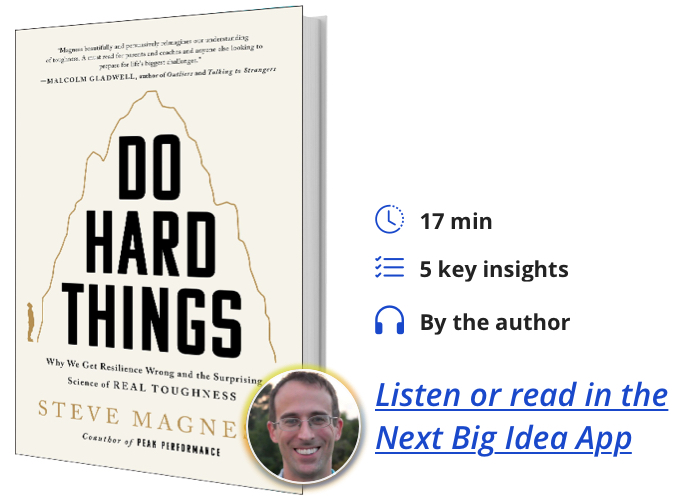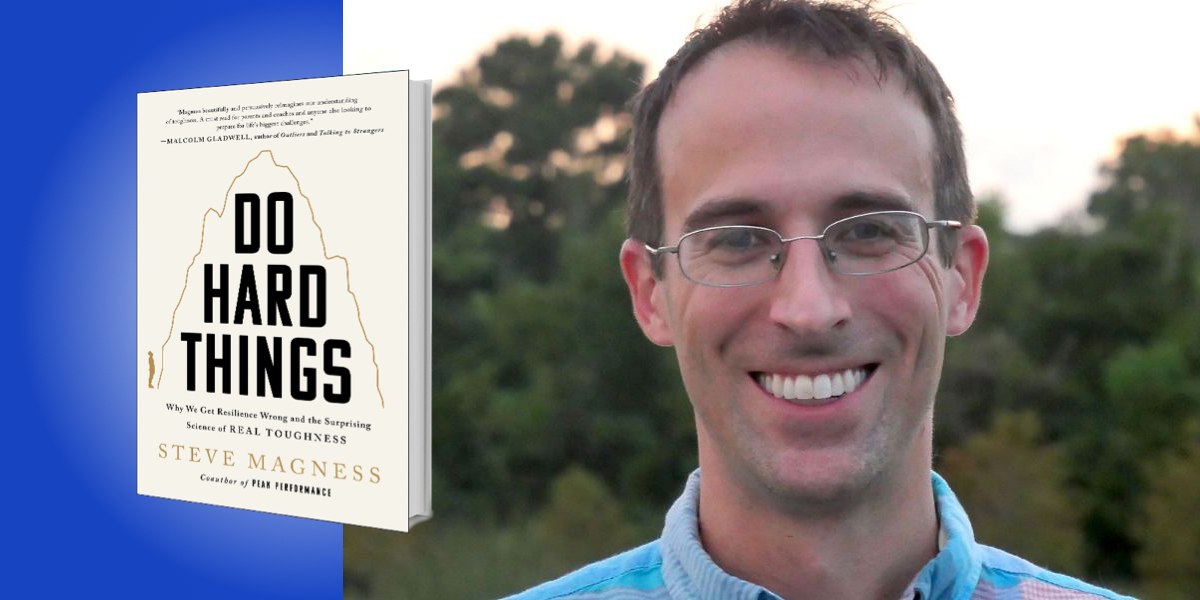Steve Magness is a writer and performance coach who has worked with Olympians, professional athletes, and executives and entrepreneurs to help them perform when it matters most. He has spent the last five years studying resilience.
Below, Steve shares 5 key insights from his new book, Do Hard Things: Why We Get Resilience Wrong and the Surprising Science of Real Toughness. Listen to the audio version—read by David himself—above or in the Next Big Idea App.

1. Acting tough isn’t the same as being tough.
We have a fundamental misunderstanding of what it means to be tough. We hold on to ideas that better resemble a middle school football coach’s ideal of toughness than reality. We mistake toughness for strength, power, and control. Our definition of toughness has, unfortunately, revolved around a belief that the toughest individuals have thick skin, fear nothing, constrain emotions, and hide vulnerability. In other words, they are callous.
Look at the language we use: we say to “man up,” and tell people they are “soft.” In the corporate world, we prop up the companies that create slick-looking ads promoting values of inclusion and diversity, all while the inner workings of those organizations are littered with abuse, hostility, and harassment. We’ve chosen the glitzy Instagram filter of toughness. It’s the bully version, projecting strength, masking the hurt and insecurity within. Some of the world’s best performers tell us that the old school method backfires. Demanding parents and coaches lead to less disciplined, less persistent individuals. It fails in the military, where the most resilient soldiers show high levels of emotional flexibility, and high levels of humble confidence. It fails in sport, where athletes who fall for the old model play out of fear, leading to worse performance.
It’s time to move to a definition based on navigating discomfort by creating space to take thoughtful action. Toughness is about responding, not reacting. It’s about authentic connection and belonging, not leadership through fear. For far too long, we’ve propped up an external version of toughness based on bluster and machismo while neglecting inner strength based on humility and equanimity. Real toughness is quiet and comes deep from within. It’s about making the right choice under stress, uncertainty, and fatigue—this requires emotional control. Real toughness is borne of self-security that is rooted in confidence, but not arrogance. Toughness is about figuring out how to thrive in adversity, and isn’t concerned with posturing.
2. Understand your inner world—don’t avoid it.
If you’re like me and grew up in sports, you learned that feelings are enemies. Don’t show emotion. Ignore what you feel. We send the same message in the workplace, parenting, and beyond. Our inner world isn’t the enemy. It protects from physical or psychological threat, such as shielding our ego from the bruise of failing a job interview. Feelings and emotions are messengers from our bodies that relay what’s going on. Don’t shun them; decipher their language instead.
“Research shows that the best stockbrokers, endurance athletes, and military personnel are better at reading their inner signals.”
Research shows that the best stockbrokers, endurance athletes, and military personnel are better at reading their inner signals. Think of a four-year-old. They throw tantrums because they have little idea what that barrage of emotions is when their teacher tells them to redo their work, or when a friend rejects them on the playground. You see this in young kids’ vocabulary—they explain every emotion as “sad.” Hopefully, adults can differentiate between sadness and frustration, shame, boredom, or isolation.
In psychology, the ability to add nuance to emotional experience is called interoception. Experts in interoception don’t push away sensations, they learn to understand them. Only once we speak their language can we know how to deal with them. To know if that pain is a warning that injury is imminent, or if that feeling of shame is an uninformed feeling that we should scroll on by. Tough individuals are expert at listening to their body.
3. Bravado backfires.
Imagine being dropped in the woods with a friend or two and asked to live off the land to survive. In the U.S. military, this is part of everyone’s training. It’s called SERE: survival, evasion, resistance, and escape. Studies find that up to 96 percent of individuals experience dissociation during the training—the fog of war. Some handle it better than others.
I talked to individuals who went through this crucible, and they reported the same thing. As one soldier put it, “When there’s a difference between what you project and what you are capable of, it all crumbles under stressful situations. On the other hand, if you’re honest with yourself, and acknowledge your strengths and weaknesses, what you’re capable of and what might scare you, then you can come to terms with what you’re facing and deal with it. It’s not bravado, it’s humble confidence. A little doubt keeps you sharp.” Research backs this up. We want our perception of the difficulty of a challenge and our ability to handle it to be realistic and overlap. When we go in with bravado, it backfires because at the first inkling that we may not be able to succeed, our brain freaks out.
Resilience is tied to low levels of denial and the ability to face fears—being able to encounter challenges, not through delusion, but with realistic optimism, the belief that it may be difficult, but we possess the skills to persevere. We need humble confidence to carry us through.
“If you’re honest with yourself, and acknowledge your strengths and weaknesses, what you’re capable of and what might scare you, then you can come to terms with what you’re facing and deal with it.”
4. Respond, don’t react.
When researchers at the University of Wisconsin compared how a group of expert meditators and novices handled a hot probe being applied to their wrists, initially there weren’t many differences. Both rated the pain at about a 7 out of 10. But as they peered into their brains using fMRI technology, a difference emerged. The experts’ threat-detecting area in the brain (the amygdala) remained silent. Their novice counterparts’ amygdala lit up, sounding the alarm. When they dug further, the expert meditators had a “greater ability to fully embrace the feeling of pain and … let go of the appraisal of what the pain meant to them.” They’d learned to observe the itch without scratching. They were creating space to respond, instead of freak out.
It’s not just meditators. It’s the child who doesn’t jump from frustration to temper tantrum. The basketball player who doesn’t miss a shot, and then fear that she’s lost her touch. The spouse who can listen to their partner, instead of yelling during an argument. Responding is keeping our head cool amid chaos.
We create space to respond by sitting with discomfort. Expert meditators hone this through years of practicing letting thoughts and feelings float on by. The rest of us don’t necessarily need meditation, but we need to accept discomfort. We can train this in everyday situations: pause when you feel that incessant urge to check your phone, or listen to your family member express their political views instead of interrupting. You can be intentional in training your capacity to respond. Jump in a cold shower and practice relaxing instead of tensing up. Go for a hard run. Have a calm conversation instead of catastrophizing when pain rises.
Whenever you feel the urge to react, pause, take a few deep breaths, and sit with that urge. You are training your mental muscle to be in control, to be considerate, and deliberate with your response. In a world that pushes us towards reacting, slowing down to respond is a skill society desperately needs.
5. Real toughness comes from satisfying core needs.
When under pressure, we often default to a controlling leadership style. We dictate and demand, believing that we are taking charge and creating order out of disorder. This often backfires.
“When we satisfy basic needs, we create an environment where people play to win, instead of playing not to lose.”
When a team of organizational psychologists studied the NBA, they found that a coach’s behavior in a single season influenced their performance for the rest of their career. In evaluating almost seven hundred players’ performance, those who played under a coach with an abusive leadership style saw a drop in performance, as measured by a player efficiency score. But the effects weren’t limited to the season with that coach. The impact stretched to the player’s entire career. The player’s career trajectory shifted a notch downward. Not only did their performance drop, but the coach’s style rubbed off on them. Those players had more technical fouls (an indicator of aggression) throughout the rest of their career.
When you look at what works over the long haul, research shows that athletes perform better and are more resilient when their basic psychological needs are met. When an environment provides these four things, they perform better:
- Being supported, not thwarted: having input, a voice, and a choice.
- The ability to make progress and grow.
- Feeling connected to the team and mission; a sense of belonging.
- Finding purpose or meaning in the pursuit.
This isn’t just in sports. In the workplace, a recent study of over 1,000 office workers showed that the strongest predictor of how well they dealt with demanding work was whether they felt respected and valued by their managers. In other research, those who report feeling more autonomy and less micromanaging have higher levels of job satisfaction and performance. Toughness is amplified when we have a choice and feel like we can make a difference.
When we satisfy basic needs, we create an environment where people play to win, instead of playing not to lose. When fear dominates, we perform worse. Outliers can handle playing out of fear, but for most of us, security gives the freedom to perform. For decades we thought callousness was the key to toughness. It turns out the real secret sauce is being a decent human being who actually cares about others.
To listen to the audio version read by author Steve Magness, download the Next Big Idea App today:































